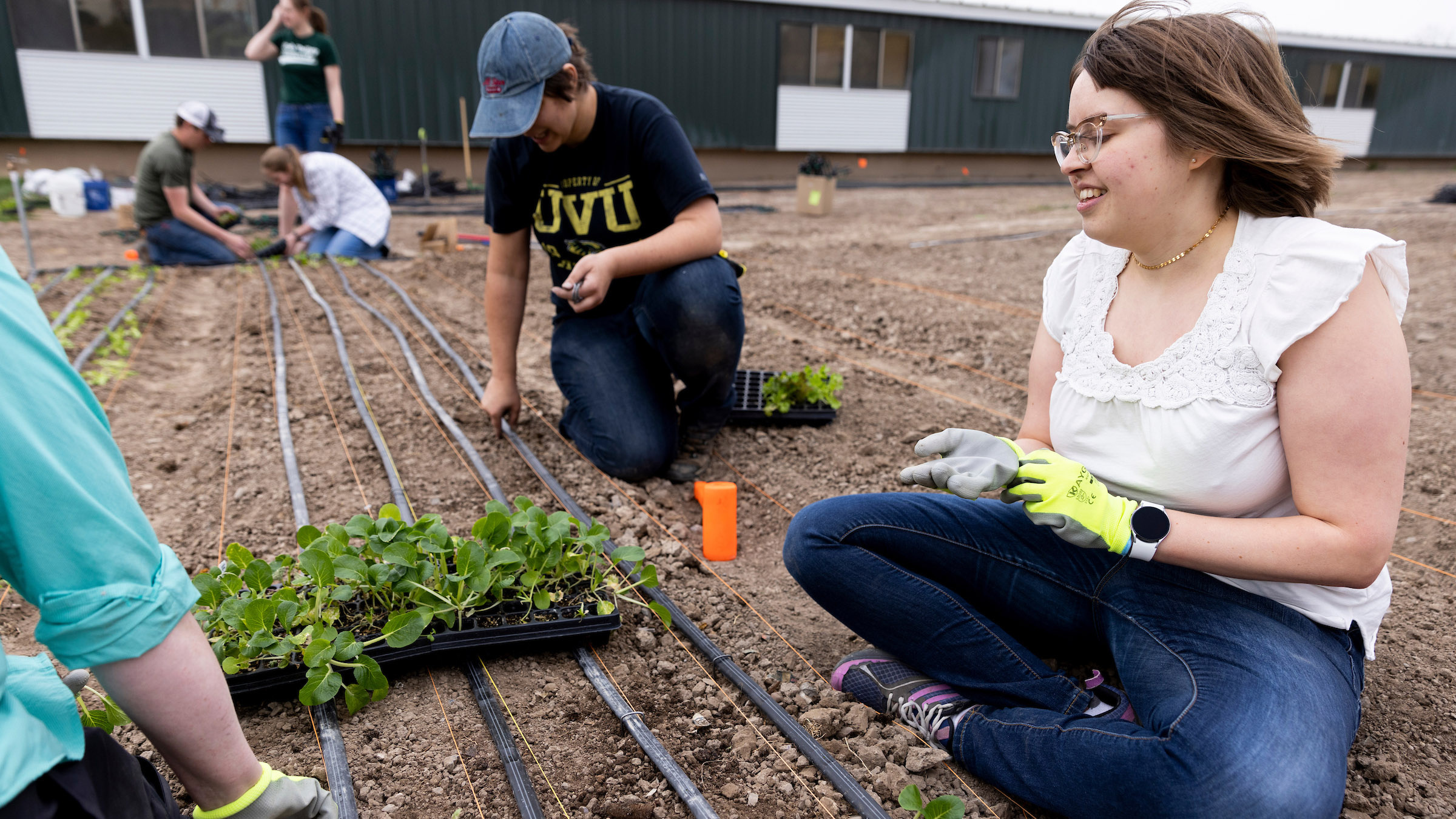Volunteers gathered this week in UVU's Growing Resilience & Inclusiveness Together (GRIT) Garden to begin forming beds and planting produce seeds as part of Earth Week at UVU.

Volunteers gathered this week in Utah Valley University’s Growing Resilience & Inclusiveness Together (GRIT) Garden to begin forming beds and planting produce seeds as part of Earth Week at UVU.
The garden, located on a 65-foot piece of land east of Utah County Academy of Sciences (UCAS), will grow fresh produce for the UVU Food Pantry and will provide an inclusive space for academic research, campus and community education, and for the community to mindfully connect with nature.
“It's nice to get your hands in the dirt,” said Allie Asay, who works with the UVU Sustainability Committee to raise awareness for the garden. “It's a good way to just kind of step back from everything and recognize what's real and concrete.”
According to Austin Harvey, lab manager in UVU’s biology department, the idea for the garden started with a discussion in the Sustainability Committee. Harvey thought it would be useful for the biology department to have some garden space to teach horticulture classes in. Someone else mentioned that they could grow fresh produce for the campus food bank. Some health professionals said it would be great to promote mental health through gardening. They decided that a garden is something everyone could participate in, so they all came together to make it happen.
“This is almost two-and-a-half years or something like that in the making,” he said. “I'm really excited for the community outreach that we're going to have, the ability to feed people in need on campus, and all of those things that check a lot of boxes for me. I'm just excited to get it going.”
The garden was partially funded through a partnership between UVU and Jostens, a company that delivers graduation gowns made from 100% post-consumer recycled plastic or other recycled materials. Each biodegradable gown in the Jostens Evergreen Collection has a code on the hang tag that students can redeem on their website. For every code redeemed, Jostens donates $1 to a university to support sustainability efforts or projects. During the graduation fest on campus, UVU collected 876 tags, which equated to $876 dollars from Jostens for the garden.
“I'm most excited about getting the community really involved,” said Boston Swan, UVU’s greenhouse director since February. “Everyone I talked to about it is really thrilled. I think that's really exciting to bring everyone together around this garden.”
On Thursday, the volunteers planted salanova lettuce. Soon the garden will include the addition of bok choy, broccoli, and other winter vegetables. In May, employees and volunteers will plant vegetables such as tomatoes, peppers, cucumbers, and squash for the summer season.
“I think caring about the environment and sustainability is a way that UVU can demonstrate our core values of exceptional care, exceptional accountability, and exceptional results,” said UVU Sustainability Coordinator Genevieve Richards.
Richards explained that the garden provides a chance for UVU to support what they call the “three P's of sustainability,” which are: people, planet and prosperity. True sustainability benefits all of those things. First, the garden supports people by helping them get involved with the garden to connect socially and to get outside for their mental and physical health.
“This community garden is a great way for people who may not normally interact on campus to interact with each other and build connections,” Richards said. “And they can be social connections, but they can also be educational and professional connections.”
Second, the GRIT project benefits the planet by allowing people to get food from the garden, which may have a lower environmental impact than getting food from the grocery store. Third, the project supports prosperity by providing fresh produce at the UVU Food Pantry for students in need.
According to Swan, the pantry goes through hundreds of pounds of food in just a few hours. The addition of fresh produce will provide those in need with necessary nutrition.
Swan and Harvey are both looking forward to the future of the garden, for which there are many plans in the works. Eventually, they want the garden to include permanent plants such as fruit trees. That way, they will be able to teach people how to prune and care for trees as well as give high-value crops to people who wouldn't normally have access to them.
Harvey said the outside portion will have 5,620 footbeds, and they’ll build a 24-by-100-foot greenhouse there that includes 1,820 footbeds. The Sustainability Committee plans to grow crops that indigenous peoples grew previously here, grow plants for ceremonial purposes on campus, and start a horticulture program to teach people tasks like setting up a drip irrigation system.
The goal of the garden is to be inclusive, Harvey said. He hopes that everyone from everywhere will come to the garden to learn something and bounce ideas off each other. With Thursday’s planting in the books, the GRIT garden can begin its great work.
“It's great to see something physically manifest from hard work,” volunteer Christy Houston said. “And to be able to see the green go into the ground and know that you're helping your fellow students, and know that you're making a difference. It's just gold.”